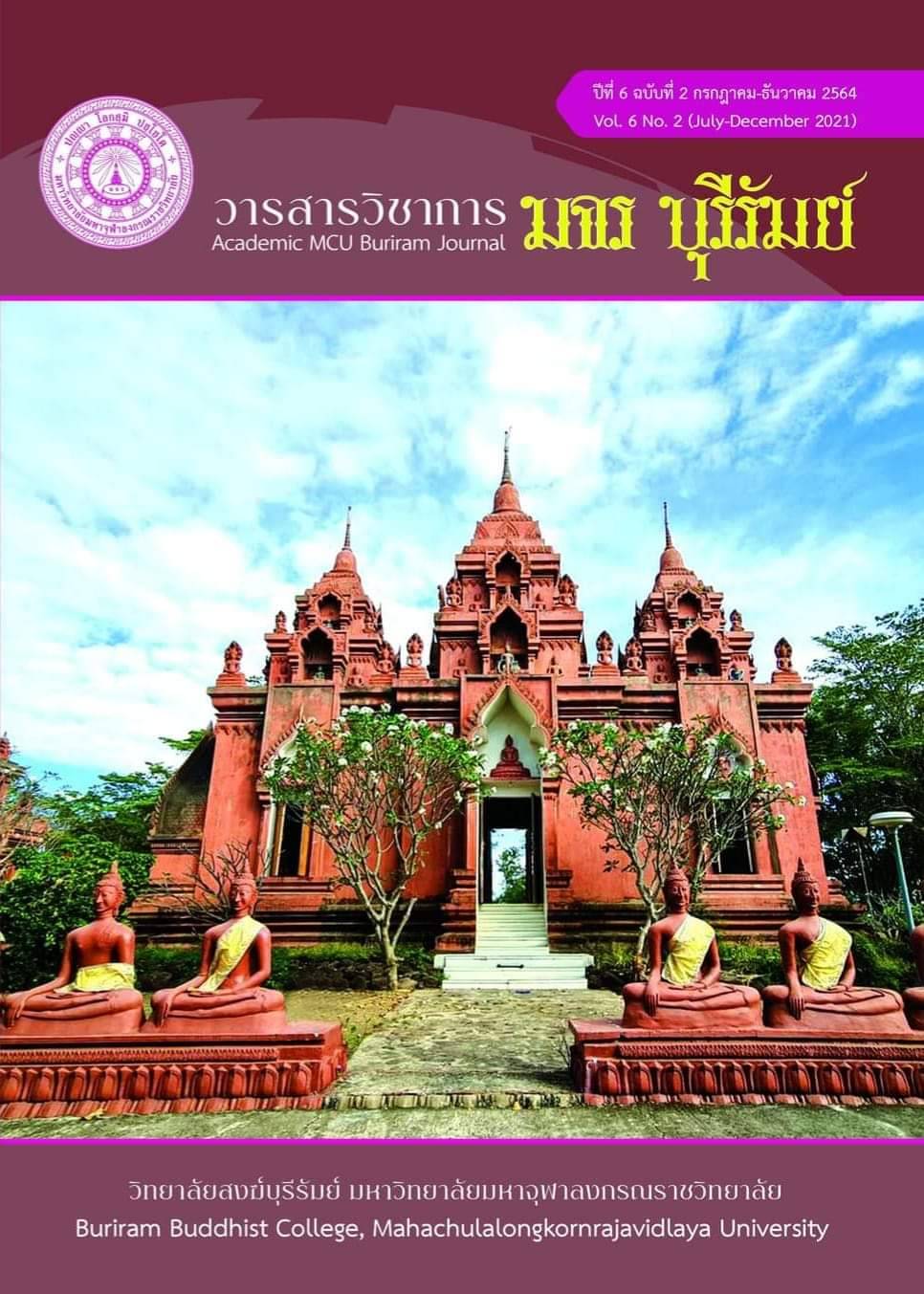An Analytical Study of the Beauty in Prasat Muangtam according to Theravada Buddhist Philosophy
Keywords:
Beauty, Prasat Mueangtam, Theravada Buddhist PhilosophyAbstract
This research has three objectives: 1) to study the history of Prasart Mueangtam, 2) to study the beauty in Theravada Buddhist philosophy, 3) to study and analyze the beauty of Prasart Mueangtam according to Theravada Buddhist philosophy. Researcher have study the Tipitaka, the scriptures of Theravada Buddhism, academic documents and related research. The datam were analyzed by a descriptive method.
The results of the research found that:
The construction of Prasart Muangtam is regarded as a castle in the ancient Khmer civilization with beautiful design and elaborate etiquette in accordance with the art form of that period. Special attention was given to the construction, there was a structured plan.
The beauty in Theravada Buddhist philosophy is that deep within the mind, which is pure without additives. It could be a moral quality or things that persuade the feeling of appreciation of the Beauty prevails all around us, both the human being and the natural. The beauty has both external beauty and inner beauty. The outside beauty is beautiful appearance, which will depend on the values of that society that will evaluate the external beauty. The inner beauty or the beautiful mind is a noble beauty, It is a universal beauty, does not depend on the manipulation of the society.
The beauty of Prasart Muangtam according to Theravada Buddhist Philosophy is that it is the beauty of the mind or the beauty of the spiritual nature, which is the beauty that is born from the state of mind based on the dharma state. The appearance shows imitation of nature seen as a condition of sensitivity, gentleness. The beauty that appears in the Prasart Mueangtam can be seen from the relationship of appearance. It arises from the relationship between philosophical concepts, religion and the perfection of craftsmanship, which resulting in a harmony of these elements, the harmony between the philosophical, religious and philosophical concepts are unity. It is causing beauty that is extremely valuable.
References
มหาจุฬาลงกรณราชวิทยาลัย. (2539). พระไตรปิฎกภาษาไทย ฉบับมหาจุฬาลงกรณราชวิทยาลัย. กรุงเทพมหานคร: โรงพิมพ์มหาจุฬาลงกรณราชวิทยาลัย.
กรมศิลปากร. (2529). จารึกในประเทศไทย เล่ม 3 อักษรขอม พุทธศตวรรษที่ 15-16. กรุงเทพมหานคร: กรมศิลปากร.
กลุ่มวิชาการโบราณคดี สำนักงานศิลปากรที่ 12 นครราชสีมา. โบราสถานในจังหวัดบุรีรัมย์. นครราชสีมา: ม.ป.ท., ม.ป.ป.
คณะกรรมการบริหารสภาวัฒนธรรมจังหวัดบุรีรัมย์. (2555). บุรีรัมย์ภูมิหลังประวัติศาสตร์และวัฒนธรรม. กรุงเทพมหานคร: บริษัท ที.เค. พริ้นติ้ง จำกัด.
คณะกรรมการฝ่ายประมวลเอกสารและจดหมายเหตุ. (2544). วัฒนธรรมพัฒนาการทางประวัติศาสตร์ เอกลักษณ์และภูมิปัญญา จังหวัดบุรีรัมย์. กรุงเทพมหานคร: กรมศิลปากร.
พิริยะ ไกรฤกษ์. (2520). ข้อคิดเห็นเกี่ยวกับแบบศิลปะในประเทศไทย คัดเลือดจากพิพิธภัณฑสถานแห่งชาติสาขาส่วนภูมิภาค. กรุงเทพมหานคร: กรมศิลปากร.
พัชรินทร์ ศิริอำพันธ์กุล. อีสานใต้ศึกษา เล่ม 1 ประวัติศาสตร์และวัฒนธรรมท้องถิ่นบุรีรัมย์. บุรีรัมย์: ม.ท.ป., ม.ป.ป.
พระธรรมปิฎก (ป.อ. ปยุตฺโต). (2546). พจนานุกรมศาสตร์ ฉบับประมวลธรรม. พิมพ์ครั้งที่ 12. กรุงเทพมหานคร: โรงพิมพ์มหาจุฬาลงการณราชวิทยาลัย.
พระพรหมคุณาภรณ์ (ป.อ.ปยุตฺโต). (2551). พจนานุกรมพุทธศาสน์ ฉบับประมวลศัพท์. กรุงเทพมหานคร: โรงพิมพ์มหาจุฬาลงกรณราชวิทยาลัย.
พระพรหมคุณาภรณ์ (ป.อ.ปยุตฺโต). (2545). พุทธธรรม. พิมพ์ครั้งที่ 20. กรุงเทพมหานคร: โรงพิมพ์ บริษัท สหธรรมิก.
พระมหาทวี มหาปญฺโญ (ละลง). (2555). ความงามในพระพุทธศาสนา. พิมพ์ครั้งที่ 1. กรุงเทพมหานคร: ภาพพิมพ์.
พระมหาถนอม อานนฺโท. (2560). คุณค่าและอิทธิพลของปราสาทขอม. พิมพ์ครั้งที่ 1. กรุงเทพมหานคร: สาลพิมพการ.
วนิดา ขำเขียว. (2543). สุนทรียศาสตร์. กรุงเทพมหานคร: พรานนกการพิมพ์.
วิทย์ วิศทเวทย์. (2513). ปรัชญาเบื้องต้น. กรุงเทพมหานคร: โรงพิมพ์ไทยวัฒนา พานิชจำกัด.
วิธาน สุชีวคุปต์. (2549). อภิปรัชญา. พิมพ์ครั้งที่ 7. กรุงเทพมหานคร: มหาวิทยาลัย รามคำแหง.
วิบูลย์ ลี้สุวรรณ. (2537). ศิลปะกับชีวิต. กรุงเทพมหานคร: สำนักพิมพ์คอมแพคท์พริ้นท์.
สุเชาวน์ พลอยชุม. (2555). สารัตถะวิชาการพุทธปรัชญา. พิมพ์ครั้งที่ 1. กรุงเทพมหานคร: มหามกุฎราชวิทยาลัย.
สุเชาวน์ พลอยชุม. (2534). (ผู้แปล) สุนทรียศาสตร์ ปัญหาและทฤษฎีเกี่ยวกับความงามและศิลปะ. โดย จี ศรีนิวาสัน, พิมพ์ครั้งที่ 2. กรุงเทพมหานคร: โรงพิมพ์มหามกุฏราชวิทยาลัย.
สรเชต วรคามวิชัย. (2529). ปราสาทเมืองต่ำ. บุรีรัมย์: วิทยาลัยครูบุรีรัมย์.
พระวัฒนา ญาณวโร. (2558). การศึกษาความงามของพระธาตุนาดูนตามหลักพุทธปรัชญาเถรวาท. ดุษฎีพุทธศาสตรดุษฎีบัณฑิต. บัณฑิตวิทยาลัย: มหาวิทยาลัยมหาจุฬาลงกรณราชวิทยาลัย.
พระมหารังสันต์ กิตฺติปญฺโญ. (2553). การศึกษาวิเคราะห์สุนทรียศาสตร์ในพุทธปรัชญาเถรวาท. วิทยานิพนธ์พุทธศาสตรมหาบัณฑิต. บัณฑิตวิทยาลัย: มหาวิทยาลัยมหาจุฬาลงกรณราชวิทยาลัย.
พระมหาถนอม อานนฺโท. (2560). คุณค่าและอิทธิพลของกลุ่มปราสาทขอมที่มีต่อวิถีชีวิตของชุมชนท้องถิ่นจังหวัดบุรีรัมย์. ทุนสถาบันวิจัยพุทธศาสตร์: มหาวิทยาลัยมหาจุฬาลงกรณราชวิทยาลัย.
Downloads
Published
How to Cite
Issue
Section
License
ทัศนะและความคิดเห็นที่ปรากฏในบทความวารสารฉบับนี้ถือเป็นความรับผิดชอบของผู้เขียนบทความนั้น ไม่ถือเป็นทัศนะและความรับผิดชอบของบรรณาธิการ





